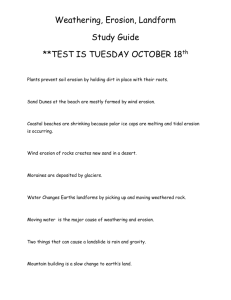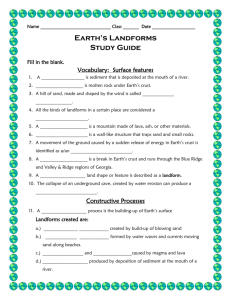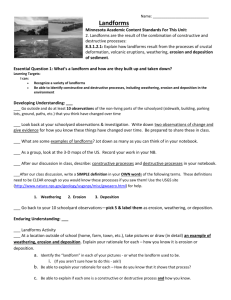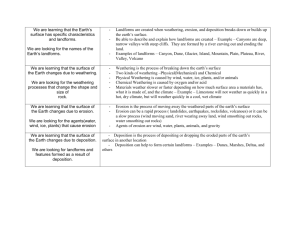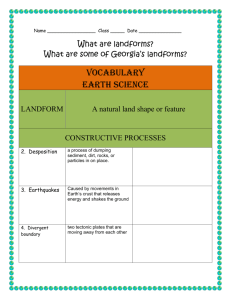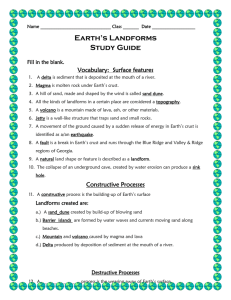CHAPTER 7: LANDFORMS AND THEIR EVOLUTION Landforms
advertisement
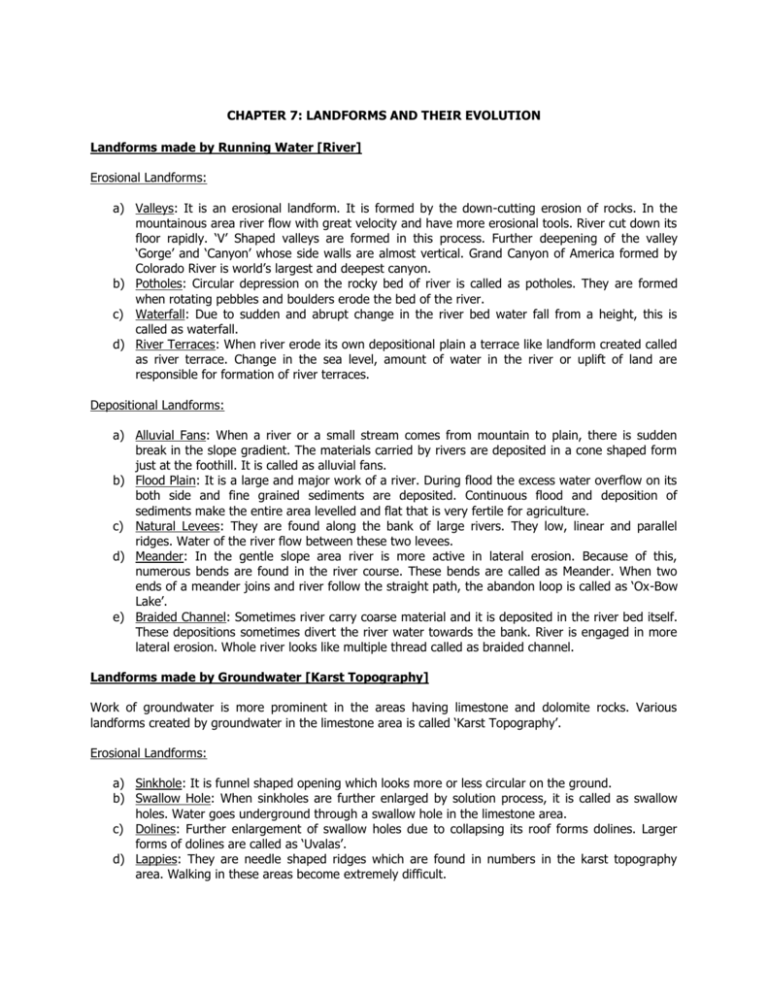
CHAPTER 7: LANDFORMS AND THEIR EVOLUTION Landforms made by Running Water [River] Erosional Landforms: a) Valleys: It is an erosional landform. It is formed by the down-cutting erosion of rocks. In the mountainous area river flow with great velocity and have more erosional tools. River cut down its floor rapidly. ‘V’ Shaped valleys are formed in this process. Further deepening of the valley ‘Gorge’ and ‘Canyon’ whose side walls are almost vertical. Grand Canyon of America formed by Colorado River is world’s largest and deepest canyon. b) Potholes: Circular depression on the rocky bed of river is called as potholes. They are formed when rotating pebbles and boulders erode the bed of the river. c) Waterfall: Due to sudden and abrupt change in the river bed water fall from a height, this is called as waterfall. d) River Terraces: When river erode its own depositional plain a terrace like landform created called as river terrace. Change in the sea level, amount of water in the river or uplift of land are responsible for formation of river terraces. Depositional Landforms: a) Alluvial Fans: When a river or a small stream comes from mountain to plain, there is sudden break in the slope gradient. The materials carried by rivers are deposited in a cone shaped form just at the foothill. It is called as alluvial fans. b) Flood Plain: It is a large and major work of a river. During flood the excess water overflow on its both side and fine grained sediments are deposited. Continuous flood and deposition of sediments make the entire area levelled and flat that is very fertile for agriculture. c) Natural Levees: They are found along the bank of large rivers. They low, linear and parallel ridges. Water of the river flow between these two levees. d) Meander: In the gentle slope area river is more active in lateral erosion. Because of this, numerous bends are found in the river course. These bends are called as Meander. When two ends of a meander joins and river follow the straight path, the abandon loop is called as ‘Ox-Bow Lake’. e) Braided Channel: Sometimes river carry coarse material and it is deposited in the river bed itself. These depositions sometimes divert the river water towards the bank. River is engaged in more lateral erosion. Whole river looks like multiple thread called as braided channel. Landforms made by Groundwater [Karst Topography] Work of groundwater is more prominent in the areas having limestone and dolomite rocks. Various landforms created by groundwater in the limestone area is called ‘Karst Topography’. Erosional Landforms: a) Sinkhole: It is funnel shaped opening which looks more or less circular on the ground. b) Swallow Hole: When sinkholes are further enlarged by solution process, it is called as swallow holes. Water goes underground through a swallow hole in the limestone area. c) Dolines: Further enlargement of swallow holes due to collapsing its roof forms dolines. Larger forms of dolines are called as ‘Uvalas’. d) Lappies: They are needle shaped ridges which are found in numbers in the karst topography area. Walking in these areas become extremely difficult. e) Caves: Long and wide gap are called caves. They are formed when limestone dissolves into the water. A cave having opening at both the ends are called as tunnel. Depositional Landforms: a) Stalactities: They are found in the cave. They hang from the ceiling and develop downwards. They are cone shaped structure formed due to evaporation of dripping water. b) Stalagmites: It is formed by the deposition of materials by the dripping water on the floor of a cave. They are also smooth with conical shape which developed toward the roof of the cave. c) Cave Pillar: When stalactite and stalagmite join together, they look like a pillar in the cave called cave pillar. Landforms Made by Glaciers Moving mass of ice on the mountain is called as glacier. They move slowly and downward on the mountain slope due to gravity of the earth. Glaciers move only few centimetres in a day. Erosional Landforms: a) Cirque: They are most common landform in glaciated mountain. They are deep, long and wide trough or basin. They look like armchair. They are also called as corrie. b) ‘U’ Shaped Valley: The valley created by glacier has vertical side wall and flat floor which looks like ‘U’ of English alphabet. Smaller ‘U’ Shaped valley when joins the main valley, it is called as hanging valley. c) Arêtes & Horn: When numerous cirques develops on both side of a mountain, many toothed ridges are formed that is called as arêtes. When many cirques are formed around a mountain peak, the mountain peak looks like cone or a pyramid called as horn. d) Fiords: When glacial troughs are filled with the sea water, the seacoast become highly irregular and dissected that is called as fiords. Depositional Landforms: a) Moraines: The load or sediments carried by a glacier is seen in its U Shaped Valley, when glacier is melted down. These sediments are called as moraines. There are four types of moraines: i) Lateral Moraines, ii) Ground Moraines, iii) Medial Moraines and iv) Terminal Moraines. b) Eskers: During summer when ice of the glacier melts, a tunnel is formed into the ice and water flow through it. The fine sediments brought by melted water is deposited to form eskers. Eskers are very important for transportation purpose. c) Drumlins: They are smooth oval shaped ridges formed by deposition of gravel and sand brought by glaciers. Drumlins look like an inverted boat or spoon. d) Outwash Plain: From the point the melt into water a levelled land is formed by movement of melt water and deposition of sediment. It is called as outwash plain. In other words, the plain formed by glacier is called as outwash plain. Landforms Made by Sea Waves a) Cliff: It is steep rocky coast rising vertically above the sea water. Cliffs are formed by erosion of coastal rocks by the action of breaking waves. b) Wave Cut Platform: The flat area from the cliff to the sea water is called wave cut platform. Due to continuous erosion of the rocky coast the cliff recedes [move backwards] forming a flat area called as wave cut platform. c) Bars and Barriers: Sea waves when parallel to the sea coast move, they deposit sand parallel to the coast. It is called as bars. Larger forms of bars are called as barriers. When one end of a bar is connected with land and another end is open in the sea, it is called as ‘hook’. d) Lagoon: It is a lake in the sea. It is formed when a part of the sea water is completely closed by bars or barriers. Chilka Lake in Orrisa is the best example. e) Beach: Beach is formed by continuous erosion of rocks and deposition of sand by the breaker sea waves. Beaches are very attractive for tourist. f) Arch and Stack: Caves are formed in the coast due to erosion by sea waves. When two caves are joined due to further erosion the whole structure is called as ‘arch’. When roof of the arch is collapsed due to further erosion the standing pillar is called as ‘stack’. Landforms Made by Wind [Desert Landform] Work of wind is more prominent in desert areas. Various kinds of landforms are created due to erosion, transportation and deposition by the wind. a) Mushroom Rock: When the lower part of vertically standing rocks is eroded from all sides, its look like a mushroom and it is called mushroom rock. b) Deflation Basin: High speed wind blow out the sand and gravel from an area. The depression formed by this process is called deflation basin. c) Demoiselles: They are pillars of soft rock with a hard rock cap on its top. It is formed due to varying erosion of soft and hard rocks. d) Sand Dunes: Heap and mound of sand found in the desert area is called as sand dunes. These sand dunes move slowly towards the direction of the wind. There are two types of sand dunes: i) Longitudinal Sand Dunes, and ii) Transverse Sand Dunes. A crescent shape [semi-circular] sand dune is called as ‘Barchan’. e) Loess: Sometimes, light and fine particle of sand are blown up to a great distance and their deposition make levelled plain that is called as loess. In other words, plain formed by wind due to deposition of fine particle of sand is called as loess. Loess plain of China is the best example. f) Balson: In the desert area, a basin between the mountains is called as ‘Balson’. The rocky land from the foothill of the mountain towards the basin is called as ‘Pediment’. A temporary lake formed due to numerous streams coming from the mountain to basin during the rainy season is called as ‘Playa’.
